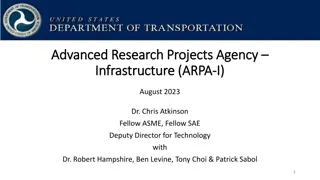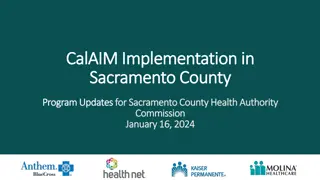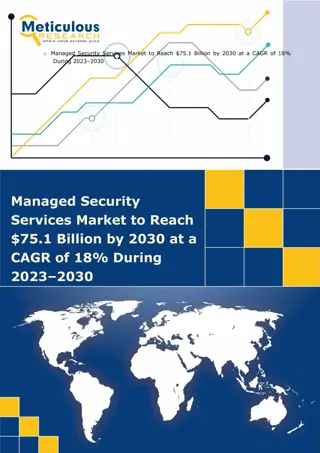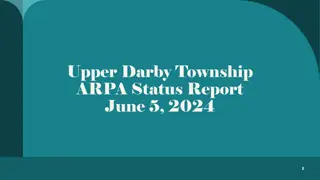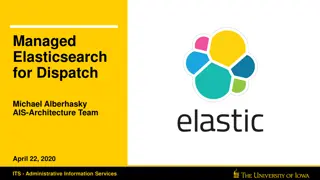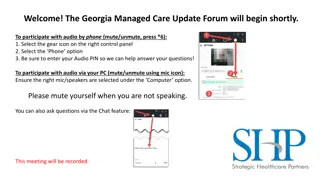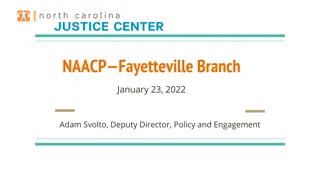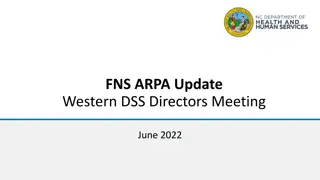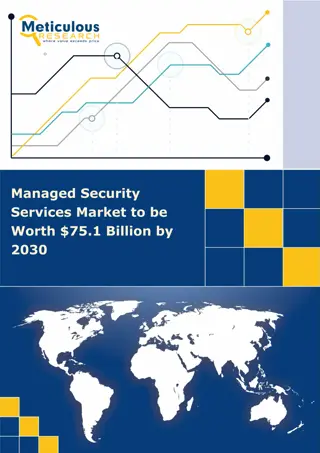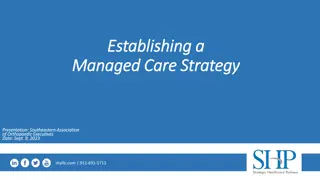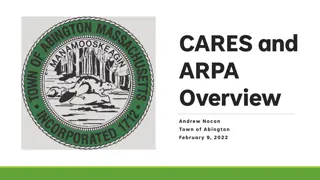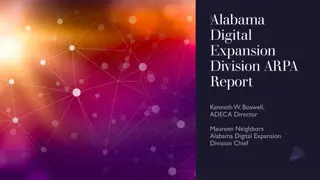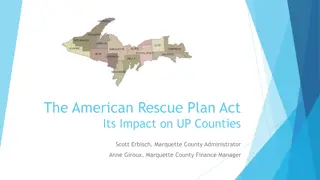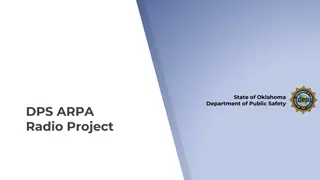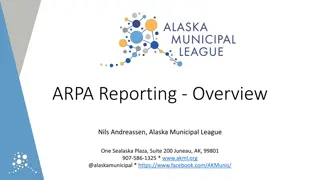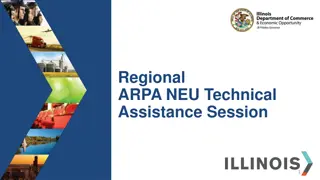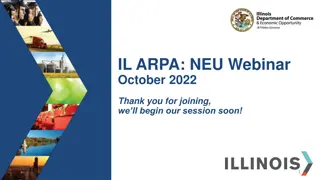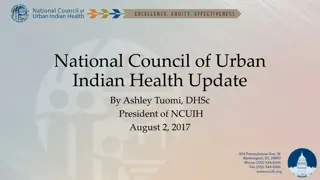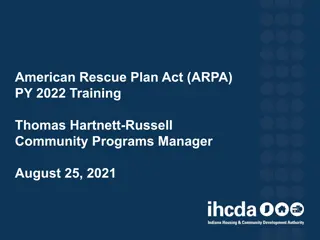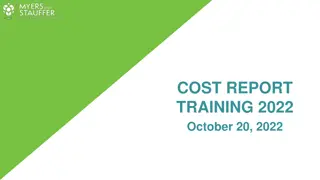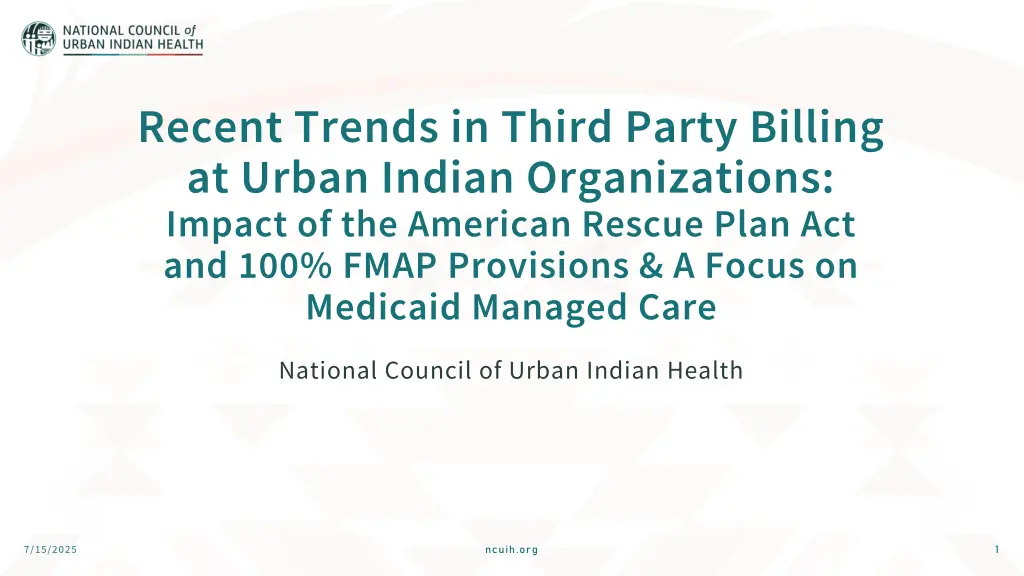
Recent Trends in Third-Party Billing at Urban Indian Organizations
Explore the impact of the American Rescue Plan Act and 100% FMAP provisions on third-party billing practices at Urban Indian Organizations. Learn about the Medicaid managed care landscape and key considerations for maximizing billing efficiency and compliance.
Download Presentation

Please find below an Image/Link to download the presentation.
The content on the website is provided AS IS for your information and personal use only. It may not be sold, licensed, or shared on other websites without obtaining consent from the author. If you encounter any issues during the download, it is possible that the publisher has removed the file from their server.
You are allowed to download the files provided on this website for personal or commercial use, subject to the condition that they are used lawfully. All files are the property of their respective owners.
The content on the website is provided AS IS for your information and personal use only. It may not be sold, licensed, or shared on other websites without obtaining consent from the author.
E N D
Presentation Transcript
Recent Trends in Third Party Billing at Urban Indian Organizations: Impact of the American Rescue Plan Act and 100% FMAP Provisions & A Focus on Medicaid Managed Care National Council of Urban Indian Health 7/15/2025 ncuih.org 1
Welcome! Isaiah O Rear, M.A., M.Ed Health Policy Statistician Chandos Culleen, JD Director of Federal Relations, Public Policy 7/15/2025 ncuih.org 2
ABOUT The National Council of Urban Indian Health (NCUIH) is the national non-profit organization devoted to the support and development of quality, accessible, and culturally-competent health and public health services for American Indians and Alaska Natives (AI/ANs) living in urban areas. NCUIH is the only national representative of the 41 Title V Urban Indian Organizations (UIOs) under the Indian Health Service (IHS) in the Indian Health Care Improvement Act (IHCIA). NCUIH strives to improve the health of the over 70% of the AI/AN population that lives in urban areas, supported by quality health care centers. 7/15/2025 ncuih.org 3
Recent Trends in Third Party Billing at Urban Indian Organizations: Impact of the American Rescue Plan Act and 100% FMAP Provisions National Council of Urban Indian Health 7/15/2025 ncuih.org 4
Learning Objectives What is the Federal Medical Assistance Percentage (FMAP), and why does it matter in Urban Indian Healthcare? Major Changes in the American Rescue Plan Act How do Medicaid reimbursement rates relate to fiscal impact of 100% FMAP provisions? How Much Medicaid Costs are Shifted from States due to ARPA Implementation? What if the 100% FMAP provision was permanent? Best practices for the remaining period of 100 percent FMAP under ARPA, and beyond 7/15/2025 ncuih.org 5
Roadmap Introduction to Urban Indian Organizations Background: FMAP and Urban Indian Health Data Analysis Discussion & Recommendations 7/15/2025 ncuih.org 6
Introduction to Urban Indian Organizations (UIOs) 7/15/2025 ncuih.org 7
Declaration of national Indian health policy Congress declares that it is the policy of this Nation, in fulfillment of its special trust responsibilities and legal obligations to Indians to ensure the highest possible health status for Indians and urban Indians and to provide all resources necessary to effect that policy. 7/15/2025 8 ncuih.org
The Role of Urban Indian Organizations in the Indian Health System 7/15/2025 9 ncuih.org
UIOs receive just 1% of the IHS budget and has failed to keep pace with inflation and the growing urban Indian population. In 2018, while average health care spending was $11,172 per person, Congress appropriated just $672 per AI/AN patient at UIOs. Congress appropriated just $73.4 for urban AI/AN health in Fiscal Year 22, less than 40% of the National Tribal Budget Formulation Workgroup s recommendation for the Urban Indian Health line item 7/15/2025 ncuih.org 10
7/15/2025 ncuih.org 11
7/15/2025 ncuih.org 12
Background: FMAP and Urban Indian Health 7/15/2025 ncuih.org 13
What is the Federal Medical Assistance Percentage The cost of services provided to Medicaid beneficiaries is shared between the federal government and the state Medicaid program in which the individual is enrolled. The share of covered services provided to Medicaid beneficiaries which is covered by the federal government is referred to as the Federal Medical Assistance Percentage (FMAP). The Social Security Act (SSA) sets forth a formula by which the FMAP and state share are determined; as a baseline a FMAP cannot be less than 50% of the cost. The FMAP formula is based on a state s average personal income states which have lower average personal incomes receive a higher FMAP 7/15/2025 ncuih.org 14
FMAP and the Indian Health Care Improvement Act (IHCIA) In 1976, Congress passed IHCIA Added Section 1911 of the SSA to authorize reimbursement by Medicaid for services provided to AI/AN Medicaid beneficiaries in IHS and Tribal health care facilities Amended section 1905(b) of the SSA setting FMAP at 100% for Medicaid services which are received through an Indian Health Service facility whether operated by the Indian Health Service or by an Indian tribe or tribal organization Formalized the Federal government s relationship with UIOs, directing HHS to enter into contracts with UIOs for the provision of health services to AI/ANs living in urban areas. UIO were not included in the IHCIA s amendments to the SSA and therefore services provided at a UIO were not eligible for 100% FMAP. 7/15/2025 ncuih.org 15
Major Changes in the American Rescue Plan Act (ARPA) In March 2021, the Biden Administration authorized 8 fiscal quarters of 100% FMAP coverage for Medicaid services received through UIOs and Native Hawaiian Health Care entities for IHS-beneficiaries through ARPA (Section 9815) 100% FMAP went into effect on April 1, 2021 (the beginning of Quarter 3 of FY2021). Provision expires at the end of Quarter 3 of Fiscal Year 2023. SEC. 9815. EXTENSION OF 100 PERCENT FEDERAL MEDICAL ASSISTANCE PERCENTAGE TO URBAN INDIAN HEALTH ORGANIZATIONS AND NATIVE HAWAIIAN HEALTH CARE SYSTEMS. Section 1905(b) of the Social Security Act (42 U.S.C. 1396d(b)) is amended by inserting after (as defined in section 4 of the Indian Health Care Improvement Act) the following: ; for the 8 fiscal year quarters beginning with the first fiscal year quarter beginning after the date of the enactment of the American Rescue Plan Act of 2021, the Federal medical assistance percentage shall also be 100 per centum with respect to amounts expended as medical assistance for services which are received through an Urban Indian organization (as defined in paragraph (29) of section 4 of the Indian Health Care Improvement Act) that has a grant or contract with the Indian Health Service under title V of such Act; and, for such 8 fiscal year quarters, the Federal medical assistance percentage shall also be 100 per centum with respect to amounts expended as medical assistance for services which are received through a Native Hawaiian Health Center (as defined in section 12(4) of the Native Hawaiian Health Care Improvement Act) or a qualified entity (as defined in section 6(b) of such Act) that has a grant or contract with the Papa Ola Lokahi under section 8 of such Act 7/15/2025 ncuih.org 16
CMS State Health Official (SHO) Letter On August 30, 2021, CMS issued SHO Letter #21-004 which confirmed that CMS is interpreting the amendments made by section 9815 of the ARP [sic] to authorize 100 percent FMAP for expenditures for services received by all Medicaid beneficiaries through UIOs, NHHCs, and NHHCSs. 7/15/2025 17 ncuih.org
All-Inclusive Rate FMAP All-Inclusive Rate (AIR) The AIR refers to a reimbursement rate set by IHS and billed by IHS and Tribal facilities for services provided to Medicaid beneficiaries on a per encounter basis. IHS publishes the AIR in the Federal Register Annually (the 2022 AIR is $640 for Medicaid outpatient visits in the lower 48 states) Most UIOs do not currently receive the AIR for encounters with Medicaid beneficiaries 7/15/2025 ncuih.org 18
Medicaid reimbursement rates and fiscal impact of 100% FMAP provisions While ARPA required the federal government to reimburse state Medicaid agencies at 100% for Medicaid services received by Medicaid beneficiaries at a UIO, it did not establish a reimbursement methodology or rate at which those services were to be paid to the UIO. The CMS SHO Letter informed State Health Officials that because ARPA Section 9815 is silent with regard to payment rates, [s]tates have the discretion to set and adjust Medicaid provider payment rates, consistent with section 1902(a)(30)(A) of the [Social Security Act]. CMS offered to provide technical assistance to states interested in adjusting their reimbursement rates for UIOs. A state interested in making changes to Medicaid payment rates must submit a state plan amendment (SPA) to CMS 7/15/2025 ncuih.org 19
Data Analysis 7/15/2025 ncuih.org 20
Data Source and Methods NCUIH Methods NCUIH analyzed 2019 Medicaid claims data from 30 UIOs submitted to CMS via the Transformed Medicaid Statistical Information System (T-MSIS). Using T-MSIS data, NCUIH was able to: 1. compile an aggregate estimate for all Medicaid payments made to UIOs in 2019, 2. forecast future payments through 2022 based on national medical expenditure growth, and 3. estimate the amount of state-federal cost-shifting due to Section 9815 of ARPA under different scenarios. 7/15/2025 ncuih.org 21
How Much Medicaid Costs are Shifted from States due to ARPA Implementation? $70,407,559 of UIO Medicaid costs would shift from State governments to the Federal government if all 22 states with UIOs drew 100% FMAP during the two-year period of the temporary 100% FMAP provision. Year Estimated Medicaid Payments to UIOs* 2019 $89,504,467 2021 $98,676,437 2022 $104,498,348 *Funding estimates based on T-MSIS payments and national medical expenditure growth rates. Distribution of cost-shifting across California, Montana, and Arizona. 7/15/2025 ncuih.org 22
What if the 100% FMAP provision was permanent? NCUIH estimates predict that over ten years, $450 million of costs would be shifted from states to the federal government. Annual Cost Per- Average FMAP Average FMAP 2-Year Cost Shift 10-Year Cost Patient in 2021 Rate in 2022 (2021-2022) Shift* (2021- 2030) CBO Estimates $2,000 57% 57% $155,000,000 $941,000,000 NCUIH Estimates $1,306 65.1% 65.6% $70,407,559 $547,432,000 (based on T- MSIS) 7/15/2025 ncuih.org 23
Why NCUIH Estimates Vary from CBO Estimates? CBO Assumptions $2,000 of annual per- patient costs. NCUIH Assumptions $1,036 of annual per-patient costs, based on 2019 T-MSIS data. 90,000 Medicaid patients per year. 86,666 Medicaid patients per year, based on 2019 T-MSIS data. 57% average national FMAP rate for 2021 and 2022. 65.1% average FMAP rate for 2021 and 65.6% FMAP rate for 2022 for states with UIOs. 7/15/2025 ncuih.org 24
Strengths, Limitations, and Unknowns Unknown Data Limitation on Analysis Strength NCUIH s report is the only known analysis based on actual billing volume at UIO instead of national averages. UIO growth compared to national trends. Analysis assumes growth in Medicaid payments to UIOs will follow general national trends, but UIOs may experience additional UIO-specific policy changes. Impact of pandemic on claims data. Analysis assumes pre-pandemic Medicaid billing will carry over because claims data is not yet available to examine probable changes in the population s actual usage of services during the pandemic. Future FMAP rates remain unknown until one year in advance. Ten-year estimates assume that 2023 FMAP rates remain constant through 2030. 7/15/2025 ncuih.org 25
Discussion & Recommendations 7/15/2025 ncuih.org 26
UIOs are Yet to Benefit from ARPA Section 9815 NCUIH interviewed UIOs between December 2021 and April 2022, on topics including their experience after implementation of Section 9815 of ARPA. None of the UIOs interviewed for this project had seen a financial benefit from the passing of Section 9815 of ARPA, despite its inclusion in the bill as a means of supporting pandemic response and parity for the urban Indian healthcare system. NCUIH estimates that states saved $38,912,984 without any financial benefit to UIOs as of April 2022. Only Minnesota and Colorado have elected to try to directly share their financial savings from the 100% FMAP provision of ARPA with UIOs Oregon and Montana have submitted DR SPAs to adjust UIO PPS rates during the PHE Oregon SPAs 20-0010 and 20-0019 are approved MT SPA is under review 7/15/2025 ncuih.org 27
Best practices for the remaining period of 100 percent FMAP under ARPA State-level efforts States can submit SPAs that increase reimbursement rates for Medicaid services provided at a UIO, potentially to the AIR or an UIO-specific AIR. Since ARPA was enacted, NCUIH is not aware of any SPAs drafted and submitted for the purpose of adjusting the rate paid for Medicaid services received at UIOs related to 100% FMAP. Two obstacles raised by states: short two-year time frame in which to overcome logistical hurdles and financial loss with the end of 100% FMAP Federal-level efforts CMS offered to provide technical assistance to states interested in adjusting their reimbursement rates for UIOs following passage of 100% FMAP in their SHO Letter. It is unknown how many states contacted CMS for technical assistance on rate adjustment 7/15/2025 ncuih.org 28
Permanent 100% FMAP for UIOs Approach Legislation for permanent 100% FMAP for UIOs was introduced in 2021 as H.R. 1888 and H.R. 1373. NCUIH worked closely with Congress on these parity bills. An indefinite extension might result in states supporting a rate change, submitting SPAs, and a shared benefit to states and UIOs from the financial savings How UIOs, states, and the federal government can begin to develop plans for future implementation: CMS and IHS might consider gathering a workgroup to explore enhanced reimbursement rates in advance of potential passage of indefinite 100% FMAP. UIOs and states can work together to explore options for adjustments of reimbursement dates or a UIO AIR in the event that 100% FMAP for UIOs is extended indefinitely. For example, a state could pass a statute in 2022 directing the state Medicaid agency to submit a SPA increasing the UIO reimbursement rate in the event of federal re-authorization for 100% FMAP following its expiration in 2023. 7/15/2025 ncuih.org 29
Recent Trends in Third-Party Billing at Urban Indian Organizations: A Focus on Medicaid Managed Care National Council of Urban Indian Health 7/15/2025 ncuih.org 30
Roadmap Background: Demonstrations and Waivers Data Analysis Case Studies Discussion and Recommendations 7/15/2025 ncuih.org 31
Background: Demonstrations and Waivers 7/15/2025 ncuih.org 32
What is Medicaid Managed Care? Medicaid managed care is when a state contracts with a private organization to administer all or part of their Medicaid program. There are three main types of managed care arrangements: Comprehensive risk-based managed care Primary case management (PCCM) Limited-benefit plans States can mandate enrollment in Medicaid managed care to varying extents by utilizing the following provisions of the Social Security Act (SSA): Section 1115 demonstration Section 1915 (a) and (b) waivers Section 1932 State Plan Amendment (SPA) 7/15/2025 ncuih.org 33
Section 1115 demonstrations Section 1115 permits states to make broad, structural changes to their Medicaid program, on a demonstration basis. Popular vehicle among states for waiving certain Medicaid program requirements. CMS has issued comprehensive regulations governing the submission and approval of Section 1115 demonstrations and reviews the proposal to determine if the objectives are aligned with those of Medicaid, if the proposed waiver authorities are appropriate, and if it is budget neutral. States often must engage in a lengthy negotiation process with CMS to receive approval. CMS approves Section 1115 demonstrations for an initial five-year period. Approval can be renewed for an additional 3 years and sometimes 5 years CMS has implemented a fast-track review process for Section 1115 demonstrations which have had at least one full extension cycle without substantial program changes. 7/15/2025 ncuih.org 34
Section 1915(a) and (b) Waivers The Omnibus Reconciliation Act of 1981 added Section 1915(a) and (b) of the SSA, which permit waivers for Medicaid managed care programs Section 1915 (a) A state may enter into a contract with a managed care organization to provide care and services to Medicaid beneficiaries. Beneficiary enrollment is voluntary. Currently, only a small number of states use Section 1915(a) s authority to operate managed care programs Section 1915 (b) Mandatory Managed Care Limits Medicaid beneficiaries freedom of choice among certain providers Requires dual eligibles, American Indians, and children with special health care needs to enroll in a managed care delivery system. Approval of a waiver is limited to 2 years, but may be renewed 7/15/2025 ncuih.org 35
Section 1932 SPA The Balanced Budget Act of 1997 added Section 1932, which permitted states to enroll most Medicaid beneficiaries in a managed care entity. State may pursue mandatory Medicaid managed care through an amendment to its state plan, as opposed to a waiver. Can be permanent, does not require renewal. Protections for AI/ANs: Can not require AI/ANs to enroll in a managed care entity unless the entity participating in the plan is the IHS, a Tribe or Tribal organization Indian health program, or a UIO. The American Recovery and Reinvestment Act of 2009 (ARRA) amended Section 1932 to Require non-AI/AN MCO contracts to permit AI/AN beneficiaries to choose in-network AI/AN health care providers as their primary care provider Require MCOs to demonstrate sufficient access to AI/AN health care providers for AI/AN enrollees Require that MCOs make prompt payment to AI/AN healthcare providers 7/15/2025 ncuih.org 36
Indian Managed Care Entities (IMCEs) ARRA also delineated the creation of IMCEs. An IMCE is a managed care entity that is controlled . . . by the Indian Health Service, a Tribe, Tribal Organization, or Urban Indian Organization, or a consortium, which may be composed of 1 or more Tribes, Tribal Organizations, or Urban Indian Organizations, and which also may include the Service. IMCEs may restrict enrollment under such program to Indians in the same manner as Indian Health Programs may restrict the delivery of services to Indians. 7/15/2025 ncuih.org 37
Data Analysis of Medicaid Managed Care at UIOs 7/15/2025 ncuih.org 38
Data Source and Methods NCUIH Methods NCUIH analyzed 2019 Medicaid claims data from 30 UIOs submitted to CMS via the Transformed Medicaid Statistical Information System (T-MSIS). Using T-MSIS data, NCUIH was able to: 1. compile an aggregate estimate for all Medicaid payments made to UIOs in 2019, 2. forecast future payments through 2022 based on national medical expenditure growth, and 3. estimate the amount of state-federal cost-shifting due to Section 9815 of ARPA under different scenarios. 7/15/2025 ncuih.org 39
Medicaid Managed Care at UIOs Figure 1: Medicaid Managed Care at UIOs, 2019 Medicaid Managed Care beneficiaries comprised 63% of the UIO patient population, submitted 68% of the claims, and produced 61% of the Medicaid payment revenue. The average amount paid for each Managed Care claim was only $132, significantly less than the average amount of $176 paid for non-Managed Care claims. 100% 90% 196,019 31,602 $34,592,377 80% 70% 60% Non-MCO MCO 50% 40% 414,504 54,843 $54,914,833 30% 20% 10% 0% Beneficiaries Claims Payments 7/15/2025 ncuih.org 40
Distribution of Managed Care Beneficiaries Across UIO Service Type Distribution of Managed Care Claims Across UIO Service Type Number of Beneficiaries Percentage of Total Beneficiaries Number of Managed Care Beneficiaries Percentage of Total Managed Care Beneficiaries 83.19% UIO Service Type Total Claims Percentage of Total Claims Total Managed Care Claims Percentage of Total Managed Care Claims UIO Service Type Full Ambulatory Full Ambulatory 70,948 81.86% 45,734 492,819 80.72% 351,879 84.90% Limited Ambulatory Outreach and Referral 600 0.69% 327 0.59% Limited Ambulatory Outreach and Referral 2,101 0.34% 1,308 0.32% 3,255 3.76% 1,495 2.72% 61,120 10.01% 23,053 5.56% Residential or Outpatient Treatment Center 11,863 13.69% 7,418 13.49% Residential or Outpatient Treatment Center 54,458 8.92% 38,246 9.23% Total 86,666 100.00% 54,974 100.00% Total 610,498 100.00% 414,486 100.00% 7/15/2025 ncuih.org 41
Case Studies 7/15/2025 ncuih.org 42
Mandatory or Voluntary Enrollment Enrollment in managed care is generally mandatory, but AI/ANs can choose to participate in fee-for- service plan instead. State A Beneficiaries 2 million 7-10% Enrolled Beneficiaries AI/AN Beneficiaries Medicaid Managed Care at UIOs Excellent relationship between UIOs and the state Medicaid office, which employs a Tribal Relations Liaison. Good relationship between UIOs and MCOs. UIOS report auto-enrollment into MCOs limits enrollment in AI/AN FFS program MCOs can require additional procedures and limited health options. Managed Care Section 1115 demonstration 10-20 Managed Care Organizations Urban Indian Organizations >1 Urban Indian Organization 1 Federally Qualified Health Center 7/15/2025 ncuih.org 43
State B Beneficiaries 13 million Enrolled Beneficiaries <1% AI/AN Beneficiaries Mandatory or Voluntary Enrollment AI/ANs are only required to enroll in managed care if they live in a county which operates a county-run MCO. Managed Care Primarily through 1915(b) waiver 6 Managed Care Organizations Medicaid Managed Care at UIOs UIOs report communication issues with state Medicaid office. Both the state Medicaid office and MCOs are generally unfamiliar with UIOs and AI/ANs The pandemic and increased turnover at MCOs has exacerbated communication issues. Urban Indian Organizations >1 Urban Indian Organization 1 Federally Qualified Health Center look-alike 7/15/2025 ncuih.org 44
State C Mandatory or Voluntary Enrollment AI/ANs who live in areas served by UIOs are required to enroll in managed care. Beneficiaries 1 million >2% Enrolled Beneficiaries AI/AN Beneficiaries Medicaid Managed Care at UIOs UIOs report a strong relationship with the chief executive s office. There is a statutorily mandated advisory board on unique concerns of AI/ANs in urban areas. However, relationship between UIOs and State Medicaid office is lacking MCOs do not recognize SDOH unique to AI/AN communities and culture. Managed Care Section 1915(b) waiver 9 Managed Care Organizations Urban Indian Organizations >1 Urban Indian Organization 1 Federally Qualified Health Center look-alike 7/15/2025 ncuih.org 45
State D Beneficiaries >1 million Enrolled Beneficiaries 1-3% AI/AN Beneficiaries Mandatory or Voluntary Enrollment Tribal members are not required to enroll in managed care, and may do so through affirmative voluntary choice. Managed Care Primarily through 1915(b) waiver 16 Managed Care Organizations Medicaid Managed Care at UIOs UIOs report a strong working relationship with the state on Medicaid issues due to an Urban Confer policy. The state is currently working with tribes and the UIO to create IMCEs. Urban Indian Organizations 1 Urban Indian Organization 1 Federally Qualified Health Center look-alike 7/15/2025 ncuih.org 46
State E Beneficiaries 2 million Enrolled Beneficiaries 1.4-1.9% AI/AN Beneficiaries in MCOs Mandatory or Voluntary Enrollment Tribal members can choose to enroll in a managed care plan and can use an IHS, tribal, or UIO clinic. Managed Care Primarily through 1915(b) waiver 5 Managed Care Programs Urban Indian Organizations 2 Urban Indian Organization 2 Federally Qualified Health Centers 7/15/2025 ncuih.org 47
Discussion & Recommendations 7/15/2025 ncuih.org 48
Challenges 1. Lack of communication with UIOs. 2. Lack of familiarity with the needs of AI/AN patients living in urban areas. 3. Assumption that AI/ANs living in urban areas would not want access to the same traditional healing and medicine that AI/ANs living on reservations seek. Best Practices 1. Clear and consistent communication. 2. Hire permanent tribal liaisons at state Medicaid offices and MCOs. 3. Organizational engagement and sharing between UIOs, Tribes, and other similarly situated health care providers. 7/15/2025 ncuih.org 49
7/15/2025 ncuih.org 50

